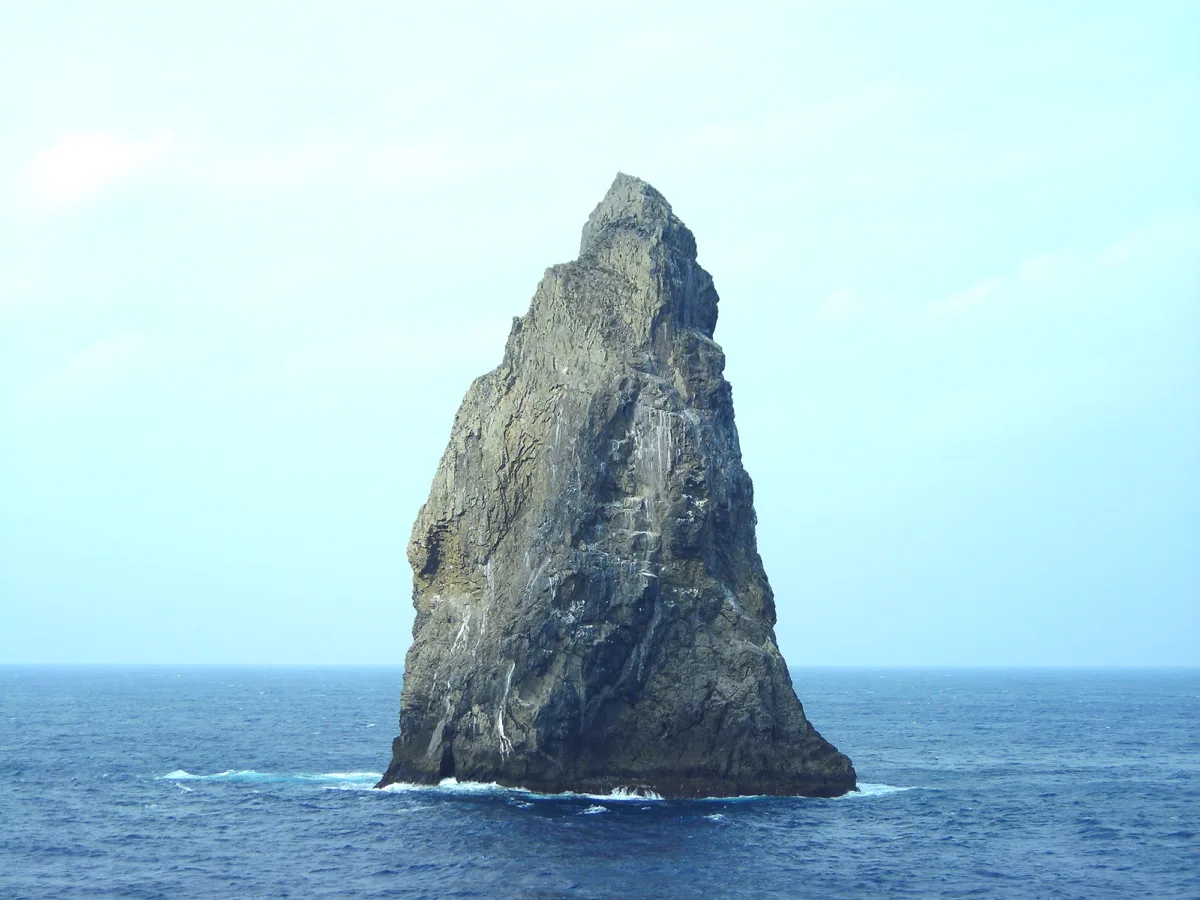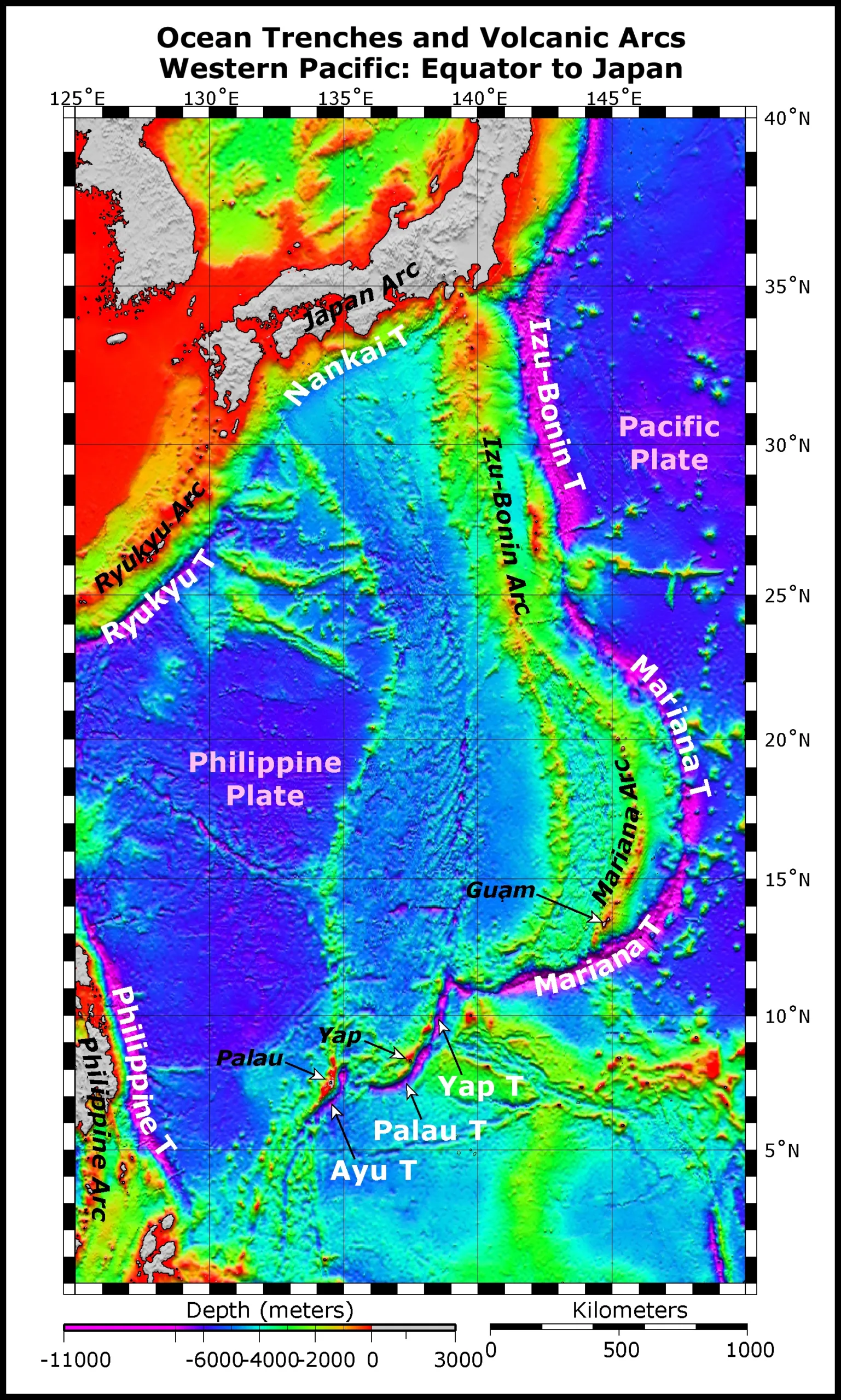
In the blue seas of the Pacific Ocean, the Izu islands stretch due south of Tokyo, Japan. Among the southernmost of these islands is Sofugan, also known as Lot’s Wife or Sofu-iwa (translated as “The Widow Crag”). This basaltic pinnacle juts 99 meters skyward, and is uninhabitable save for a few plants and seabirds whose guano sends white streaks down the rock.
This curious peak that pokes out of the ocean is separated from a submarine volcanic caldera—the Sofu Seamount—by about 10 kilometers. The seamount comprises a series of submarine volcanoes spanning approximately 20 kilometers from east to west. Both features are part of the Izu-Bonin island arc that forms as a result of subduction of the Pacific plate beneath the Philippine Sea plate along the Izu-Bonin trench.
In the first week of October in 2023, earthquakes struck in a cluster near these volcanoes. On October 8, repeating earthquakes—those that rupture in the same location and with the same sense of motion—occurred on the west side of Sofu Seamount. These repeating earthquakes triggered a tsunami advisory; following the advisory, a 60-centimeter tsunami was observed on Hachijojima Island, Japan less than 20 minutes after the last of the earthquakes. The Pacific-side of Japan also recorded tsunami waves.
In a new study published in the Journal of Volcanology and Geothermal Research, scientists Masumi Yamada from Kyoto University and Masaru Nakano from the Japan Agency for Marine-Earth Science and Technology used seismic waveforms recorded by networks in Japan and elsewhere to explore the volcanic activity that caused the tsunami waves. They focused on 15 earthquakes documented by the U.S. Geological Survey, finding further evidence of a caldera collapse under the sea.

Recent studies of the Sofu Seamount
There is limited evidence of recent volcanic activity near Sofugan; in 1975, green discolored water was observed about 500 meters north of the pinnacle. Other nearby submarine calderas are also associated with unusual earthquakes and tsunamis. Previous studies of those volcanoes suggest the presence of magmatic or hydrothermal activity.
Bathymetric surveys before and after the October 2023 events revealed that a crater about 400 meters deep and 2 kilometers wide formed on the western part of Sofu Seamount. Other studies suggested that the main source of tsunami waves was continuous uplift near Sofugan, as opposed to undersea landslides displacing large volumes of water. Findings in Yamada and Nakano’s paper support a slightly different mechanism—one of repeating uplift and subsidence in concert with magma movement.
Hydroacoustic waves
Yamada and Nakano used seismic data recorded by Japan’s F-net Broadband Seismograph Network, as well as a far-field station for comparison—the New China Digital Seismograph Network’s Beijing station (IC.BJT), accessed via the NSF SAGE archive.
The F-net stations, which are near the seismic source and considered near-field, recorded P-waves, T-waves, and surface waves; the far-field station recorded P-waves and surface waves.
T-waves are hydroacoustic waves that can be produced when, in the ocean, an earthquake’s seismic waves are converted to acoustic waves. These waves travel with little energy loss through the ocean’s SOFAR channel, and upon reaching land, are converted back to seismic waves that attenuate as they travel through Earth.
Using station IC.BJT was important because the island of Japan blocked the T-wave signal, Yamada says. “The waveform did not include T-waves, which are dominant in Japanese stations, so it is easy to compare the source duration in the P-wave [signal].”
The source of T-waves produced by 14 of the 15 earthquakes appears to be located around a collapsed crater. According to Yamada, strong T-waves are expected and detectable if the seismic source in the ocean is shallow, and the station that detects the waves is close to the coast.
Repeating earthquakes point to cycles of inflation
With the seismic data, the team estimated the source location (where an earthquake nucleated) and mechanism (how the fault moved and its orientation) via seismic wave inversion for 13 of the 15 earthquakes. They found that that these earthquakes were identical in their source and location—they are repeating earthquakes. The team also found that the time interval between events decreased as the amplitude of the seismic waves became larger.
Seismic waveforms—the squiggles recorded at seismic stations—can be broken down into their low-frequency and high-frequency components. In the low-frequency waveforms, Yamada found that the surface waves were dominant and had very long durations of about ten minutes. On the other hand, the high-frequency P-waves showed durations of only a few minutes.
The long duration of the surface waves that continued between earthquakes may be related to magma migration as the volcanic edifice gradually subsided after each quake. Thus, the repeated earthquakes and intervening signals may point to repeated episodes of inflation and deflation of the magma chamber.
The team found that the west side of the caldera was the source for the earthquakes, implying that the magma chamber was at the west end of the Sofu Seamount. Their analysis also indicated that movement during each quake was symmetric about a vertical axis. This suggests repeated vertical movement of the rock column, which, in a volcanic setting, could point to magma repeatedly entering a magma chamber, causing the caldera floor to rise. As the floor moves upward with each cycle, water is displaced, resulting in a tsunami. However, the first event did not produce a notable tsunami. The initial earthquake may have marked the opening of a path from a deeper magma reservoir to the shallow one.
Tsunami safety
Based on the magnitude of the earthquakes—between magnitude 4.3 and 5.4—the tsunami was larger than expected. That Sofu Seamount’s eruptions can produce significant tsunamis is, therefore, of concern. Because the current warning system assumes regular subduction zone earthquakes, says Yamada, “it is difficult to give a tsunami warning.”
Sofu Seamount isn’t an especially well-studied undersea volcano. “The mechanism of the volcanic eruption varies,” says Yamada. Repeating inflation and deflation wasn’t expected. “The observation of this unique mechanism will help understand the variety of the volcanic activity [for these volcanoes],” she says.

